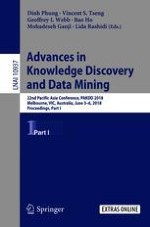2018 | Buch
Advances in Knowledge Discovery and Data Mining
22nd Pacific-Asia Conference, PAKDD 2018, Melbourne, VIC, Australia, June 3-6, 2018, Proceedings, Part I
herausgegeben von: Dinh Phung, Vincent S. Tseng, Prof. Geoffrey I. Webb, Bao Ho, Mohadeseh Ganji, Lida Rashidi
Verlag: Springer International Publishing
Buchreihe : Lecture Notes in Computer Science
